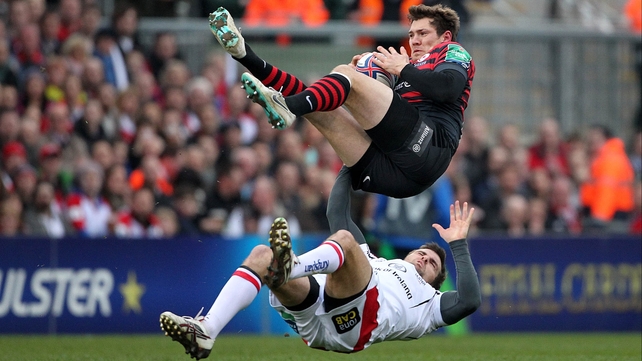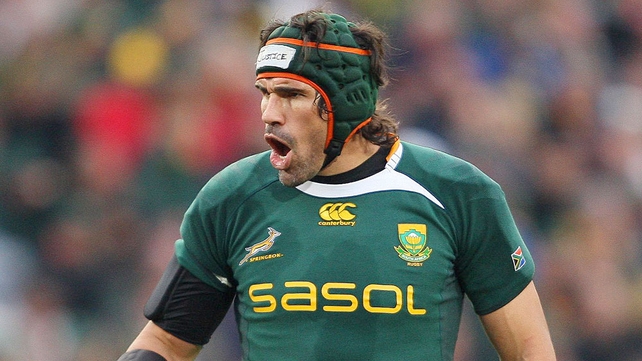By Bernard Jackman
Saturday’s match against South Africa is a huge challenge for Ireland.
Historically, this is a good time to meet the big southern hemisphere teams but I'm not sure if the timing will suit us on this occasion. We go into it ‘cold’ having last played together in June while the Springboks played as recently as October 4, when they beat New Zealand by two points to end their massive winning streak.
They arrive relatively fresh, in part due to Heyneke Meyer’s request to keep his players out of the Currie Cup in preparation for this tour, and have spent the last month working on conditioning.
Even though the European season is only three months old, the injury profile of the squad would make you think Ireland were the team at the end of a long year and running on fumes.
Despite the long injury list, Ireland have been able to select a strong side with lots of experience.
The centre pairing of Robbie Henshaw and Jared Payne is obviously the most notable call. Both have mostly been playing at outside-centre this season, though Henshaw played at 12 while wearing the 13 jersey in Connacht’s match against Exeter away in the Challenge Cup.
He has the game for the position and is physically well suited to it. Defensively he is very strong and aggressive – and not afraid to make a read and gamble.
If he can shoot up and make hits, it gives everyone a lift and against the Boks it is vital to have players who can knock them backwards.
As a ball carrier, Robbie is strong on the line, but what I really like is how he uses late footwork to find soft shoulders and also presents the ball really well.

Payne has different attributes. He has lots of pace, which he uses to give his opponent the outside and then track them down. He also has an excellent kicking game having played most of his career as a full-back and in open play he is a really dynamic runner.
I think they have the potential to be an outstanding partnership, although relationships take time to build both with each other but also with Sexton. It’s an aspect of the match that will be fascinating to watch.
Gordon D’Arcy misses out but I actually think he could start against Australia in a fortnight. It’s worth remembering that this time last year he was left out for the Australia game and brought back for New Zealand.
In terms of style, Ireland are at an interesting point in their development. The Six Nations-winning team was very well organised and followed a structured game plan with lots of phases and a low error and penalty count.
Ireland may start to move towards the offloading style that Leinster and Clermont played under Joe Schmidt. However, I’m not sure that Saturday is the game to start trying it as the Boks are probably the hardest team to dominate one-on-one. If you don’t win the collisions, it is risky to offload.
I am delighted to see Simon Zebo in the side in what is probably the largest backline Ireland have ever fielded with big strong men from Conor Murray to Rob Kearney. To be in with a chance we need a huge display from Murray.
As for South Africa, there has been lots of talk about the ‘new style’ they are going to bring to Europe but I think that has been exaggerated. They are still a team that believes territory and strong defence are the two most important performance indicators for victory.
Rassie Erasmus, their High Performance Rugby Director, is a very influential figure across all their teams and Meyer reports to him. His philosophy will impact how the Test side plays and he believes that the team that kicks the ball the most wins and is very pattern and system focused.
South Africa: Will they revert to a traditional game?
Years ago, while coaching Western Province in the Currie Cup, he experimented with a ‘Traffic Light’ system where before a scrum or lineout the nine would look up into the coaches box and be given the pattern via a system of coloured lights. That idea didn’t stick but it is a sign of a ‘coach driven’ rather than a ‘player driven’ instinct.
Meyer's background is with the Bulls, who built their success on 10-man rugby. The Boks are well aware that the World Cup will be played in Autumn conditions in Europe.
Speaking to my contacts in South Africa, they believe they will revert to type over the next 12 months, though they can mix it up and took advantage of New Zealand’s overpopulated backfield by running the ball more often than expected when they beat them.
A key for Ireland will be getting the balance between protecting the front line of their defence while also ensuring that Rob Kearney isn't exposed in the third-line.
If he does end up isolated, South Africa can kick for the corners and look to put the squeeze on Ireland’s lineout or bring their aggressive and well-organised kick-chase into play by kicking high contestable balls.
Matfield: South Africa's 'lineout God'
The set-piece will be a major battleground. It's a huge part of South Africa's armoury and the lineout in particular is key. This time last year I played against Victor Matfield in the Bermuda Classic (a knees up for veteran players in the Caribbean).
The only positive about having him against me was that I had a good excuse whenever we lost a lineout. ‘Sure the best jumper in the world stole it’. He also told me over a beer one evening that he was going to give up his coaching role with the Bulls to try and win a second Rugby World Cup. And here is, aged 37 and back playing Test rugby.
I have studied his lineout work closely and the beauty of it is the simplicity. When you compare the South African lineout to others the most obvious difference is the lack of movement before the ball is thrown in.
The stats show that Matfield is the prime target but they also have good variety through Duane Vermeulen at the back and the enforcer Eben Etzebeth at the front and can throw Mohoje up when he is in space as well.

The thing about Matfield that makes him differe nt from most other lineout generals is that he backs himself to win the ball even when he is man marked.
So even if Paul O’Connell puts a pod exclusively on him he will often call the throw on himself anyway. If he does feel well marked he can also expertly call late to whichever option is free.
He is obsessed with spacing in the lineout and the timing of the jump-lift-throw process. He loves a ‘throw-jump’ sequence, where the hooker throws the ball and he intercepts it in the air and is harder to defend against. His favourite move is a one-step lob where he actually jumps opposite his markers back lifter to give his hooker that extra 30 cm space to hit him.
Once he catches`, his ability to transfer the ball to the half-back or to set up a maul is also superb and his hands are so good that he can recover if the throw or the timing is slightly off.
It is worth noting that this week he chose to speak about how important it is that the referee makes sure Ireland are not allowed to sack the lineout drive illegally as it is a very important part of their game.
Two key players that might not be too familiar to Irish rugby fans are their new out-half Handre Pollard and centre Jan Serfontein.
Pollard has been touted as a potential Bok since he was 15 and played in three Junior Rugby World Cups.
His ability to attack the line is proven, and he is physically powerful with good pace and a step off his left foot that means he can exploit mismatches. That running ability and his strong passing game make him a different threat than Morne Steyn, but Pollard also has that big kicking game and can drop a goal if the game is tight.
Can Ireland pressure Pollard?
His left foot is far weaker than his right and Ireland must try to force him back to use it if they can. There is also a question mark about his game management, as is always the case with a young play maker.
Jan Serfontein has a similar profile and in fact they played 10 and 12 for the Bulls side in last season’s Under-21 Currie Cup final. Serfontein has played all his rugby so far as an inside-centre but Jean De Villiers presence means he plays his Test rugby at 13.
When I look at him I think ‘gain line’. He gives them go forward on both sides of the ball, attack and defence, without doing anything flashy.
Willie Le Roux is also key and gives the Boks an attacking threat from 15 and a big left boot. I also I really rate his ability to cover the back field too for the long kicks and the little grubbers in behind.
His pace is an obvious threat and he has an excellent passing game as well and can exploit opportunities on kick return and turnover.
Picking South Africa apart will be a huge challenge for Ireland. They have a pack that can deliver go-forward, both at set-piece time and as ball-carriers, and then have the ability to put us under pressure either through the boot or through running the ball.
I hope I am proved wrong, but I think that they will be too strong for us this time and my prediction is South Africa by five or six points.

